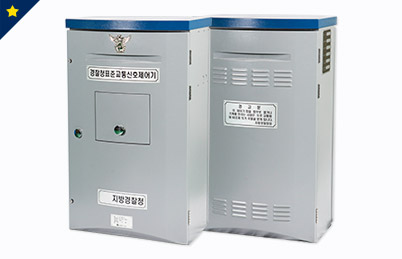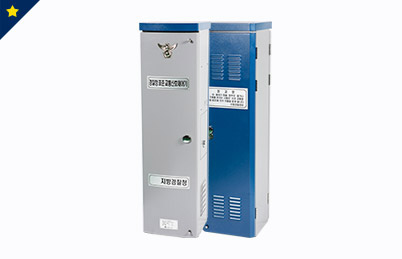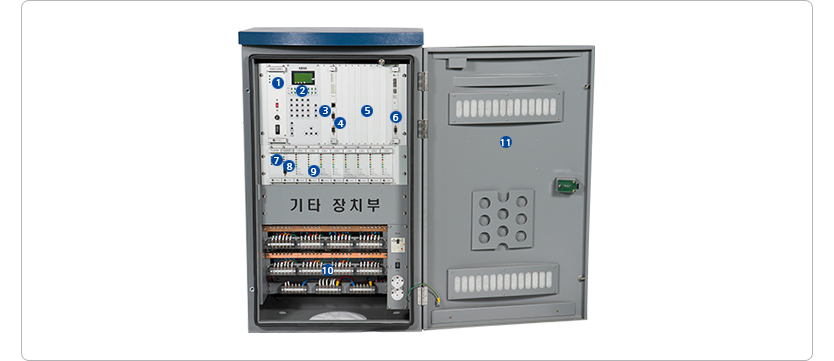- Introduction
- The traffic signal controller is a system that controls traffic signals to ensure that traffic moves as smoothly and safely as possible.
- Following the National Police Agency’s standard size, the controllers are classified into basic and slim types.
- Day and night brightness control
- Dimming control dramatically improves energy efficiency and electrical properties.

- Basic type
- Standard size by the National Police Agency
- Smooth design, with a polyhedral and curvy structure
- MODEL : ST-09ST-D (2009 Standard)ST-13ST (2010 Standard)

- Slim type
- Better design in terms of aesthetics
- Takes a smaller space for installation
- Mainly set up in the metropolitan area and new towns
- MODEL : ST-09SL-D (2009 Standard)ST-13SL (2010 Standard)
Specifications
| Specification |
SHINYTECH Traffic Signal Controllers |
Requirements |
| Main control |
MCU |
CPU |
32bit, 180MHz |
≥32 bit, 25 MHz |
| RAM |
64MB |
≥256 KB |
| FLASH |
8MB |
≥256 KB |
| Communication ports |
Six serials, one Ethernet |
Six serials |
| Vehicle detection board |
Channel no. |
Eight channels (Four are available.) |
Four–eight channels |
| Signal control |
SCU |
CPU |
32bit, 50MHz |
≥8 bit |
| RAM |
64MB |
≥64 KB |
| FLASH |
256MB |
≥64 KB |
| Function |
2016-09-12 |
Alternate half-wave control |
Half-wave control |
| LSU |
Quantity |
Six circuits, four sets |
Six circuits, four sets |
* Note : Slim-type products use an eight-channel vehicle detector.
- Application of the standard size for traffic signal controllers set by the National Police Agency
- Verified by the national certification test
- Application of high-performance/high-reliability microprocessors (32 bit)
- Design compatible with the international standard, VMEBUS (Backplane)
- The flasher function stays on with the input power only.
- Various additional options of
- • Pedestrian input card • Wire and radio card CARD • Duplex modem card • Image detector • Loop Detector • etc.
Product features
- Central remote control
- - Real-Time Control
- - Time of Day Control
- - Manual Control
- Associated control
- - Modem-based communication with the central computer
- - GPS-based time calibration
- Sensor-based control
- At intersections with large traffic fluctuations, the controller changes the traffic signal in real time
(e.g., ending the current signal early or skipping the next one) by detecting vehicles.
- - Left turn actuation
- - Spillback Control
- - Gap-Time Actuation
- - Loss-Time Actuation
- - Saturated-Flowrate Actuation
- Interaction with pedestrians
- - The controller sends out the walk signal upon the request of people in pedestrians to cross the road.
- Special control functions
- - Flashing control
- - Dimming control
- - Switch-off control
- - Signal maintenance/omission control
- - Staggered signal control
- Manual control
- In an urgent intervention of the traffic police or an emergency, special signals can be controlled using the manual buttons or the MMI.
- - Manual switch-off, flashing, etc.
- - Resetting the signals in an error state
Traffic signal controller
- Components
- the main control unit (MCU), the signal control unit (SCU), the terminal unit (T/F), and other units.

| ① Power Supply |
Power supply to MCU/SCU and other control units |
| ② MMI |
Database input and modification, controller state data |
| ③ MODEM |
Data communication with the data center (2,400 bps) |
| ④ MCU |
Traffic data collection and analysis, real-time signal control |
| ⑤ Loop Detetor Unit |
Traffic volume detection, loop cut detection |
| ⑥ GPS |
Receiving the current time from the satellite |
| ⑦ Flasher |
Operation of signal flashing in a signal control error |
| ⑧ SCU |
Signal control / output detection, signal error detection |
| ⑨ LSU : Load Switch Unit |
Traffic light operation, separate operation of traffic lights for vehicles and pedestrians |
| ⑩ Terminal board / input unit |
Traffic light / loop wire disconnection, surge protection circuit |
| ⑪ Police Panel |
Automatic/manual control, reset, normal/flashing operation |
Product features
- 1. Background
- - Dimming control function : Controls the brightness of the lights to protect drivers’ eyes at nighttime and reduce energy consumption
- - Dimming control method : An alternating current is recommended by the National Police Agency’s standard considering energy efficiency.
- - Problems of the traditional dimming control method

- 2. SHINYTECH’s Dimming control technology (patent no. 10-1214468)

- - The load switch units (LSUs) that supply power to the traffic lights are divided into Group 1 and Group 2. When the dimming control mode is on, Group 1 and Group 2 generate half waves (positive (+) and negative (–) waves, respectively) of the power signal.
- - This improves system stabilization with better energy efficiency and the protection of drivers’ eyes at nighttime, compared to the competitive products of other companies.




